Research Article :
Haslinda Z
Tamin, Siti Wahyuni and Ismet Danial Nasution The injection molding process of thermoplastic nylon produces nylon residues in the form of sprue. Nylon residues are non-biodegradable which causes serious ecological problems, hence recycling becomes a necessity. However, recycled nylon is subjected to thermal, oxidative, and mechanical degradation during process which may decrease the mechanical properties of recycled nylon. In order to overcome the decreased mechanical properties of recycled nylon, modification by combining recycled nylon with virgin nylon is considered. Thermoplastic nylon is a polymer belonging to the
polyamide category and was introduced to the market for the fabrication of
partial flexible dentures [1]. The demand for thermoplastic nylon dentures are
very high because of its advantages such as its flexibility that increases the
wearers comfort, lightness, high aesthetic values because it does not have
metal clasps and it is semi-transparent, very biocompatible because it has no
residual monomers
so it does not cause allergic reactions and it does not fracture easily [2-4].
On the other hand, thermoplastic nylon denture wearers do complaint about color
changes due to the absorption of water, also thermoplastic nylon dentures tend
to be not as retentive as it was initially (it becomes loose) due to the
permanent deformation (compressive yield strength) of the non-metal clasps but
the denture does not fracture clinically and is still intact [2,5]. Thermoplastic
nylon has a low modulus of elasticity. It is very flexible and is indicated for
patients with large undercuts. The more flexible a material, the longer it
takes for the permanent deformation to occur due to the high compressive yield
strength and vice versa, the more rigid the material, the lower the compressive
yield strength. Compressive yield strength is the strength of a material to
hold a load that exceeds the proportional limit or threshold value that causes
permanent deformation but the structure or material is still intact and not
fractured. Modulus of elasticity is the property of the material that allows it
to change its shape if it is loaded and when the load is removed it will return
to its original shape [6,7]. Injection molding technique is used to produce
thermoplastic nylon denture base, but this manipulation technique causes the
residual nylon in the form of sprue to be discharged after the polymerization
process has been completed [8]. The accumulation of this non-biodegradable residual
nylon has caused serious ecological problems due to the inability of the
residual nylon to decompose over a period of time [9]. The effort taken to
reduce environmental problems caused by the accumulation of residual nylon is
to recycle the residual nylon mechanically. However, recycled nylon is
subjected to thermal, oxidative, and mechanical degradation during processing
which will decrease the mechanical properties of the recycled nylon, when the
transition strain state of nylon is smaller, the crystalline degree decreases,
hence the elastic modulus is increased and becomes more rigid resulting in
brittle denture base. When crystalline degree of nylon increases, the elastic
modulus will decrease so the denture base becomes more ductile or flexible, ie
the compressive yield strength of the recycled nylon decreases and
the modulus of elasticity increase [10]. To counter the decreased compressive
yield strength and increased modulus of elasticity on the recycled nylon, it is
modified by the addition of virgin nylon to the recycled nylon [9]. However,
The percentage of virgin nylon should be higher than the percentage of recycled
nylon in order to increase the molecular weight to get better mechanical
properties [8,9]. Meyabadi et al recycled mechanically
by modifying virgin nylon with recycled nylon which were mixed through a
heating process with five different concentration ratios, with the ratios of
100%:0%, 75%:25%, 50%:50 %, 25%:75%, and 0%:100%. The results showed that the
crystallinity of the ratio 50%: 50% is better than 75%:25% [8]. Maspoch et.al
stated that there was a drastic decrease in the mechanical properties in
recycled nylon which were not combined with virgin nylon. The researcher also
stated that the percentage of recycled nylon must be lesser than virgin nylon and
proposed that the ratio of 30% recycled nylon with 70% virgin nylon is the best
ratio [11]. Based on the description that
has been described, research has been conducted to determine the effect of
adding 60% virgin nylon into 40% recycled nylon on the compressive yield
strength and modulus elasticity of the thermoplastic nylon
denture base, because higher percentage of recycled nylon than virgin nylon can
affect the structure of combination nylon produced [12,13]. This study is a laboratory
experimental study with three different groups; 100% virgin nylon (group A),
100% recycled nylon (group B), and combination of 60% virgin nylon with 40%
recycled nylon (group C). The samples used for elasticity modulus test were 45
rod shaped samples with dimension of 64 mm x 10 mm x 3.3 mm divided into 3
groups. Each group has 15 samples. The dimension of sample used for compressive
yield strength was 10 mm x 10mm x 4mm ± 0.2 mm in accordance with ISO (International Standard
Organization) no.604 [14]. The processing stage of nylon wastes are divided
into four stages, which are the collection and sorting stage of nylon (sorting)
in which the contaminants such as gypsum is sorted out, the cutting stage
(shredding / cutting) in which the nylon is cut using a disc bur and also a
cutter to equalize the size of nylon, washing stage to clean any residual
contaminants using aquadest and drying stage to dry any excess water using a
desicator (Duran, Germany) for 24 hours at 37˚C. The nylon beads (BioPlast,
USA) weighing 10 grams for 5 samples per injection using JET 7000 Injector W/
Moisture Filter (Snow Rock, USA) from each group was injected into a mold. The samples were trimmed with
tungsten carbide bur (Meisinger Lab TC, UK) and smoothed with waterproof sand
paper (Kinik, Indonesia) with roughness of 600, 800, 1000 and 1200 mounted on a
rotary grinder (Metaserv, England) to produce a flat surface and was continued
with polishing with a Scotch-Brite brush (3M, USA) mounted on polishing motors
(M2V Manfredi, Italy) and using coarse pumice (Kerr Dental, Swiss) until the
samples were shiny. The compressive yield strength test was performed by
compressive test and elasticity modulus test was performed with three point
bending test and the two tests were conducted using Universal Testing Machine
(Tensilon RTF, Japan). The elasticity modulus test is carried out by samples
placed on the test apparatus, given a pressure bearing on it, then the load is
given in the center continuously until the maximum load and cracking arises. The
amount of deflection or flexure that occurs during the test is recorded on each
load interval. The value of modulus of elasticity and its bending strength is
calculated based on the maximum load, pedestal distance and cross-section. The
compressive yield strength test is performed by providing the ultimate
load-bearing cycle so that the sample fails or fractures and automatically
stops the current to the motor. Data analysis was done by Univarian test, one
way ANOVA test and Turkeys HSD test. Table
1
shows the elastic modulus values of three different groups, Table 2 shows compressive yield
strength values. Table
1:
Elastic modulus values of three different groups. Table
2:
Compressive yield strength values of three different groups. The results of ANOVA test for elastic modulus and
compressive yield strength were obtained =0.0001 (p<0.05). This means that
there were statistically differences in elastic modulus values and compressive
yield strength values between group A, group B and group C with significant value
p =0.000 (p<0.05) (Tables 3 and 4). Based on the result of Turkeys HSD test
of the modulus of elasticity, there are significant differences in group A with
group B with p = 0.0001 (p<0,05), group B with group C with p = 0,007
(p<0,05) and group A with group C with p value = 0,005 (p<0,05) showed
significant differences. This means that there is an effect of adding 60%
virgin nylon into recycled nylon (Table 5). Compressive yield strength test analyzed by Turkeys HSD showed
significant differences between group A with group B, group A with group C and
group B with group C with p value = 0.0001 (p<0.05) (Table 6). Table
7:
Thermogravimetry (TGA) Analysis. Figure
1:
SEM Topography Sample of Virgin Nylon. (a) 2000x; (b) 3.000x; (c) 5.000. Figure
2:
SEM Topography Sample of Recycled Nylon. (a) 2000x; (b) 3.000x; (c) 5.000. Figure
3:
SEM Topography Sample of Combined Nylon. (a) 2000x; (b) 3.000x; (c) 5.000. Based on the results obtained from this research,
the elasticity modulus value and compressive yield strength value varied on
each sample in one group, although still in the scope of homogeneous data based
on the homogeneity test. This might be due to the influencing factors during
samples fabrication process, among others, the possibility of porosity occurred
during the injection molding process. Injection molding technique can produce
porosity during the injection of thermoplastic nylon with injectors because air
enters during the heating process. Porosity is divided into two categories,
namely macro porosity and microporosity which
requires Scanning Electron Microscopy (SEM) to detect its microporosity. Mechanical properties of a material were affected by
the porosity of the material because the higher the porosity of a material, the
lower the mechanical properties of the material would be. The material used in
this study was not fully dense because it was filled with air particles which
resulted in porosity and would cause the material to easily deform and fracture
as shown in figures 1,2 and 3 [15]. In this present study, macro porosity has
been controlled by not using a sample that visually has porosity. In addition,
to control the microporosity of this research samples, JET 7000 Injector W /
Moisture Filter Injector (Snow Rock, USA) was used, which could reduce
microporosity by creating a vacuum condition, hence air vapour might not be
able to enter. The modulus of elasticity and compressive yield strength is also
influenced by the degree of crystallinity. The
higher the degree of crystallinity of a material, the higher the compressive
yield strength, but the modulus of elasticity decreases [16]. Based on the results of one-way ANOVA test of elastic
modulus and compressive yield strength, there was statistically differences of
value in all three groups p = 0.0001 (p<0, 05). The differences between
groups A, B and C might be caused by C-C chain scission reactions due to the
mechanical recycling procedures through heating processes [5,6,8]. A virgin
thermoplastic nylon group has a peptide unit (NH-CO) which produces a hydrogen
bond between a stronger and more regular polymer chain resulting in a solid
intermolecular space. However, in the recycled nylon group there is a C-C chain
scission caused by the recycling process which will have an impact on the nylons
mechanical and physical properties [17]. The heating process that has been
carried out on the recycled nylon group will produce water vapor, thereby
increasing the nylon-bound H atom. The water molecule of H2O has an H atom on
its chemical element. Atom H will enter the chain and bind to the C atom on the
nylon so that the initially long bond of CH2-CH2-CH2 will be broken into CH2 and
CH3-CH3 so the number of CH3is more than CH2. This causes the polymer chains
formed on the recycled nylon group to become shorter and the chain bonds become
weaker and irregular because the intermolecular spaces become less compact. As
a result, the crystalline degree in the recycled nylon group is reduced and
decreases the mechanical properties of nylon [18,19]. Similarly, Soja et al
reported the effects of mechanical recycling on nylon waste. The results in
FTIR showed that ratio of methyl (CH3) increases, while methylene (CH2)
decreases as a result of chemical chain scission affecting nylons mechanical
and physical properties
[9]. The Turkeys HSD test resulted
from elastic modulus and compressive yield strength were similarly shown
statistically significant differences in between group A with B, A with C and B
with C. This could be stated that the addition of virgin thermoplastic nylon
into the recycled nylon has an effect to the elastic modulus and compressive
yield strength. This effect is due to the addition of a compatibilizer which is
virgin nylon itself, into the recycled nylon causing the hydrogen bond in
virgin nylon to fill the amorphous area of the recycled nylon causing the chemical
chain to extend. In this present study, 60% of virgin nylon hydrogen bond could
fill the amorphous region of 40% recycled nylon, hence the addition of virgin
nylon into the recycled nylon had an influence on the compressive yield
strength and elastic modulus and its value is almost as good as virgin nylon.
Bucella stated that there was an effect of adding virgin nylon into recycled
nylon due to the Densicalorimetry (DSC) used on the study shows a chain
extension reaction which would result in a good chemical chain [20]. The
modulus of elasticity and compressive yield strength is influenced by
temperature, transition glass temperature (Tg), degree of crystallinity and
molecular weight during the fabrication of nylon denture base, so it can change
at any time, if one of the factor changes its values, then the modulus of
elasticity may also change. If the modulus of elasticity it may change and will
affect the transition strain state of material when load is exerted. Hiroyuki
stated that when the transition strain state of nylon was smaller, the
crystalline degree was decreased, hence the elastic modulus was increased and
become more rigid which resulted in brittle denture base [21]. When crystalline degree of nylon
increased, the elastic modulus would decrease so the denture base became more
ductile or flexible. When the elastic modulus was higher, the transition strain
on the nylon became smaller thus resulted in the curve to increase rapidly when
stress was applied but the strain did not change rapidly and therefore the
nylon became brittle. When the elastic modulus was lower, the transition strain
state increased with rapid stretching when stress was applied but the voltage
had a slow rate of increase that caused the nylon to be flexible. The increasing
flexibility of nylon will increase the value of compressive yield strength. The
combination of virgin nylon with recycled nylon will increase the value of
transition strain state which can increase the mechanical properties of the
recycled nylon. An ideal requirement of denture base material is rigid, but a
rigid denture base will become brittle while the thermoplastic nylon is in
great demand because it is good in aesthetic and flexible. The thermoplastic
nylon has high flexibility because of its low modulus of elasticity which makes
it resistant to fracture, also making it comfortable to wear and providing
strong retention and can be used on areas with large undercuts. The high
flexibility of this nylon makes nylon not suitable in free-ended edentulous
cases without being combined with a metal frame, as it may cause leverage load
to the adjacent tooth. The results of this present study revealed that the 40%
recycled nylon combined with 60% virgin nylon had a higher modulus of
elasticity value than virgin nylon but lower than recycled nylon. These results
gave meaning in terms of ideal denture base terms. Based on ISO, the ideal denture
base requirement is to have a modulus of elasticity not less than 2000 MPA [8].
The result of this nylon combination is 1985.2 MPA close to the value of 2000
MPA. This means that combination of virgin and recycled nylon can be used for
short free-ended edentulous
cases, because the modulus of elasticity is lower but still has little
flexibility. Similarly, the compressive yield strength of Group C is higher
than Group B but lower than Group A, which means in terms of flexibility the
combination nylon is more rigid than virgin nylon but more flexible than
recycled nylon. The most common problem with thermoplastic nylon denture is the
non-metal clasps, which often undergoes permanent deformation, and therefore
the denture base is often loosened. The results this research showed that Group
C is slightly stiffer than Group A, and therefore this type of nylon can be
used in cases of clasps that require strength but not in the undercut area. The
denture base material that was produced from recycled nylon showed a high value
of modulus of elasticity, which meant it, has the disadvantage of being
brittle. It should be reminded that in combining virgin nylon with recycled
nylon, the percentage of virgin nylon should be higher than the percentage of
recycled nylon. Similarly, T Fattahi, concluded in his research that the
percentage of combined virgin nylon should be higher than the recycled nylon in
order to increase the molecular weight [8,9]. Within the limitations of this
present study, it can be concluded that recycled thermoplastic nylon can be
reused into a new denture base. However, one must pay attention to other properties
such as physical, biological, chemical, and rheological properties as well as
the requirements needed for the use as a denture base. The success and the financial
support of this research required a lot of help and assistance from many people
and our institution. We are immensely grateful to the Research Institution from
University of Sumatera Utara which funded our research expenses through the
TALENTA fund 2018. 1.
Sharma A and Shashidhara HS. A review: Flexible removable partial dentures
(2014) IOSR J Dent Med Sci 12: 58-62. https://doi.org/10.9790/0853-131265862 2.
Rickman JL, Padipatvuthiku lP and Satterthwaite JD. Comtemporary denture base
resin part: 2 (2012) Dent Update 39: 176-178. 3.
Thakral GK, Aeran H, Yadav B and Thakral R. Flexible partial dentures-A hope
for the challenged mouth (2012) Peoples J Scientific Res 5: 57-59. 4.
Tandon R, Gupta S and Agarwal SK. Denture base material: from past to future
(2010) Indian J Dental Sci 2: 37-38. 5.
Kohli S and Bhatia S. Polyamides in dentistry (2013) Int J Sci Study 1: 20-25. 6. Fueki K, Ohkubo C, Yatabe M,
Arakawa I, Arita M, et al. Clinical application of removable partial dentures
using thermoplastic resin Part II: Material properties and clinical features
of non-metal clasp dentures (2014) J Prosthodont Res 58: 73-83.
https://doi.org/10.1016/j.jpor.2014.03.002 7.
Lekha K, Savitha NP, Roseline M and Nadiger RK. Acetal Resin as an esthetic
clasp material (2012) J Interdiscip Dentistry 2: 11-14. https://doi.org/10.4103/2229-5194.94185
8.
Meyabadi TF, Mohaddes MR and Mousav SA. Melt spinning of reused nylon 6:
Structure and physical properties of as-spun, drawn, and texture filaments
(2010) J Textile Institute 101: 527-537. https://doi.org/10.1080/00405000802561085
9.
Soja J and Miskolczi N. Degradation of reinforced and unreinforced waste
polyamides during mechanical recycling (2013) Hungarian J Industry Chem
Veszreem 41: 131-136. 10.
Anusavice JK. Philips science of dental materials (2009) (11th edn) Elsevier
Mosby, Gainesville, FL, Florida, USA. 11.
Maspoch ML, Ferrando HE and Velasco JI. Characterisation of filled and recycled
PA6 (2003) Macromol Symp 194: 295-303. https://doi.org/10.1002/masy.200390096 12.
Singh K and Gupta N. Injection molding technique for fabrication of flexible
prosthesis from flexible thermoplastic denture base materials (2012) World J
Dentistry 3: 303-307. https://doi.org/10.5005/jp-journals-10015-1178 13. Jiun YL, Tze CT, Moosa U and
Tawawneh MA. Effects of recycling cycle on used thermoplastic polymer and
thermoplastic elastomer polymer (2016) Polymers Poly Comp 24: 735-740.
https://doi.org/10.1177/096739111602400909 14.
ISO 604-plastics-determination of compressive properties (2003) International
Organization for Standardization, Germany. 15.
Pero AC, Marra J, Paleari AG, De Souza RF, Compagnoni MA, et al. Reliability of
a method for evaluating porosity in denture base resins: Porosity in denture
base resins (2011) Gerodontol 28: 127-133. https://doi.org/10.1111/j.1741-2358.2009.00347.x
16.
Ali AA. Strain life failure of HDPE, PP and PMMA polymers (2013) Al-Taqani 26:
144-153. 17.
Tall S. Recycling of Mixed Plastic Waste-is Separation Worthwhile (2000) Dept
Polymer Technol, Stockholm, Sweden. 18.
Turner JW, Radford DR and Sherriff M. Flexural properties and surface finishing
of acetal resin denture clasps (1999) J Pros 8: 188-195.
https://doi.org/10.1111/j.1532-849x.1999.tb00034.x 19.
Crespo JE, Parres F, Peydro MA and Navarro R. Study of rheological, thermal and
mechanical behavior of reprocessed polyamide 6 (2013) Polymer Engineering Sci
53: 1-24. https://doi.org/10.1002/pen.23307 20.
Bucella M, Dorigato A and Pasqualini E. Thermo-mechanical properties of
polyamide 6 chemically modified by chain extension with polyamide/
polycarbonate blend (2012) J Polym Res 19: 9935.
https://doi.org/10.1007/s10965-012-9935-0 21. Hiroyuki MAE, Omiyam M and
Kishimoto K. Effects of strain rate and relaxation rate on elastic modulus of
semi crystalline polymer (2008) JASCOME 7: 1-6. Wahyuni S,
Faculty of Dentistry, Universities Sumatera Utara, Indonesia, E-mail:
sitiwahyuni_doc@yahoo.com Tamin HZ, Wahyuni S and
Nasution ID. Utilization of recycled thermoplastic nylon combined with virgin
nylon and the effect on its mechanical properties as a denture base material
(2019) Dental Res Manag 3: 51-55. Recycled nylon, Virgin nylon, Modulus of elasticity, Compressive yield strength.
Utilization of Recycled Thermoplastic Nylon Combined with Virgin Nylon and the Effect on its Mechanical Properties as a Denture Base Material
Abstract
Aim: This study aimed to determine the effect of adding virgin nylon into recycled nylon on the modulus of elasticity and compressive yield strength.
Settings and Design: Experimental laboratory research.
Methods and Materials: A total of 45 samples were used. Samples were divided into 3 groups which include 100% virgin nylon as control (A), 100% recycled nylon (B) and combination of 60% virgin nylon with 40% recycled nylon (C). The samples were tested using Universal Testing Machine (Tensilon RTF, Japan) with three point bending test and compression test with the speed of 5mm/min with ultimate load.
Statistical analysis used: The obtained results were analyzed using Univarian test, One-way ANOVA test and Turkey’s Honestly Significant Different test.
Result: There was statistical significance in adding virgin nylon into recycled nylon on its mechanical properties, namely modulus of elasticity and compressive yield strength (p<0.05).
Conclusion: The combination of 60% virgin nylon with 40% recycled nylon has better elastic modulus and compressive yield strength values compared to 100% recycled nylon. Full-Text
Introduction
Materials
and Method
Results
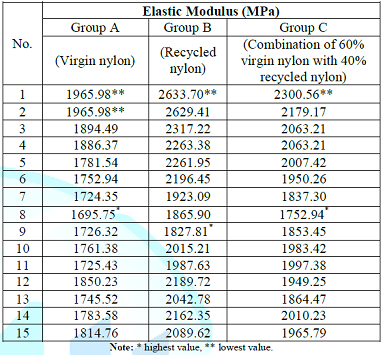
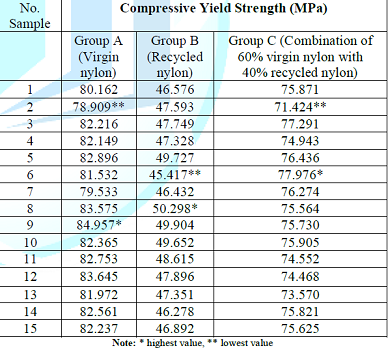




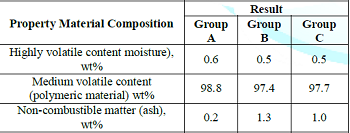
Scanning Electron Microscopy (SEM)
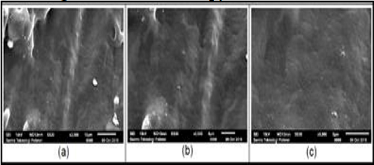
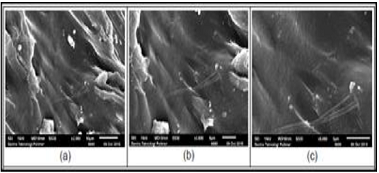
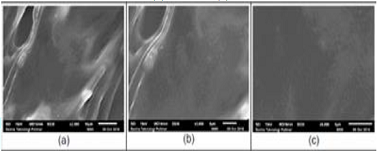
Discussion
Conclusion
Acknowledgements
References
Corresponding author:
Citation:
Keywords